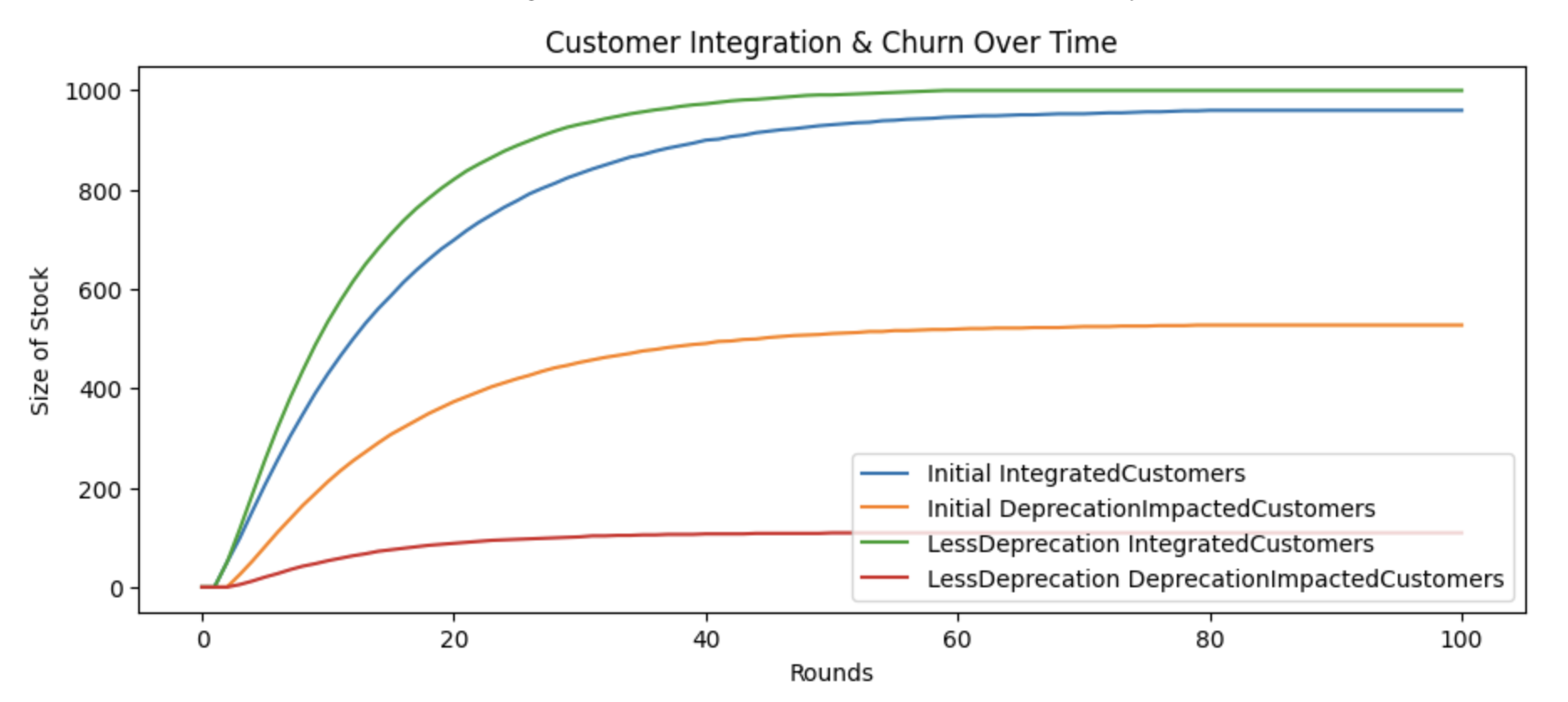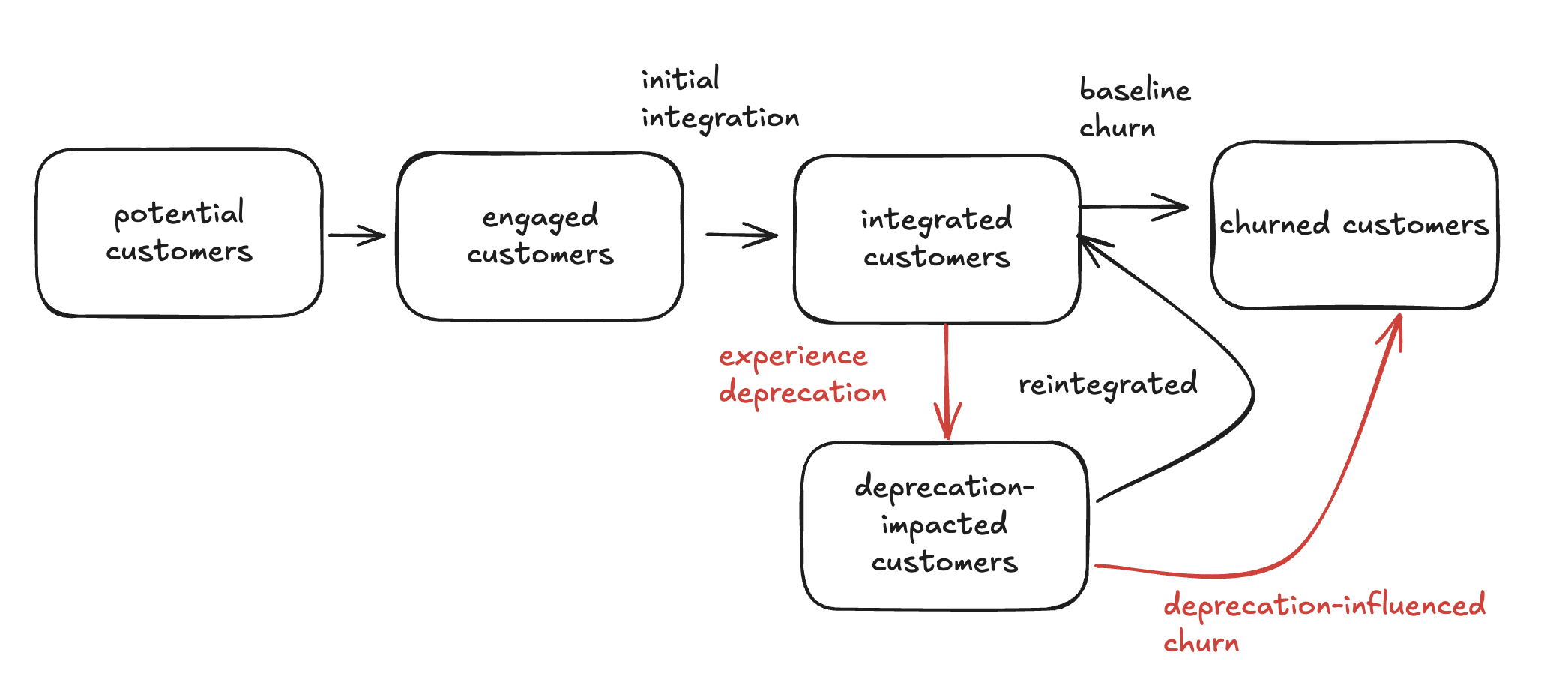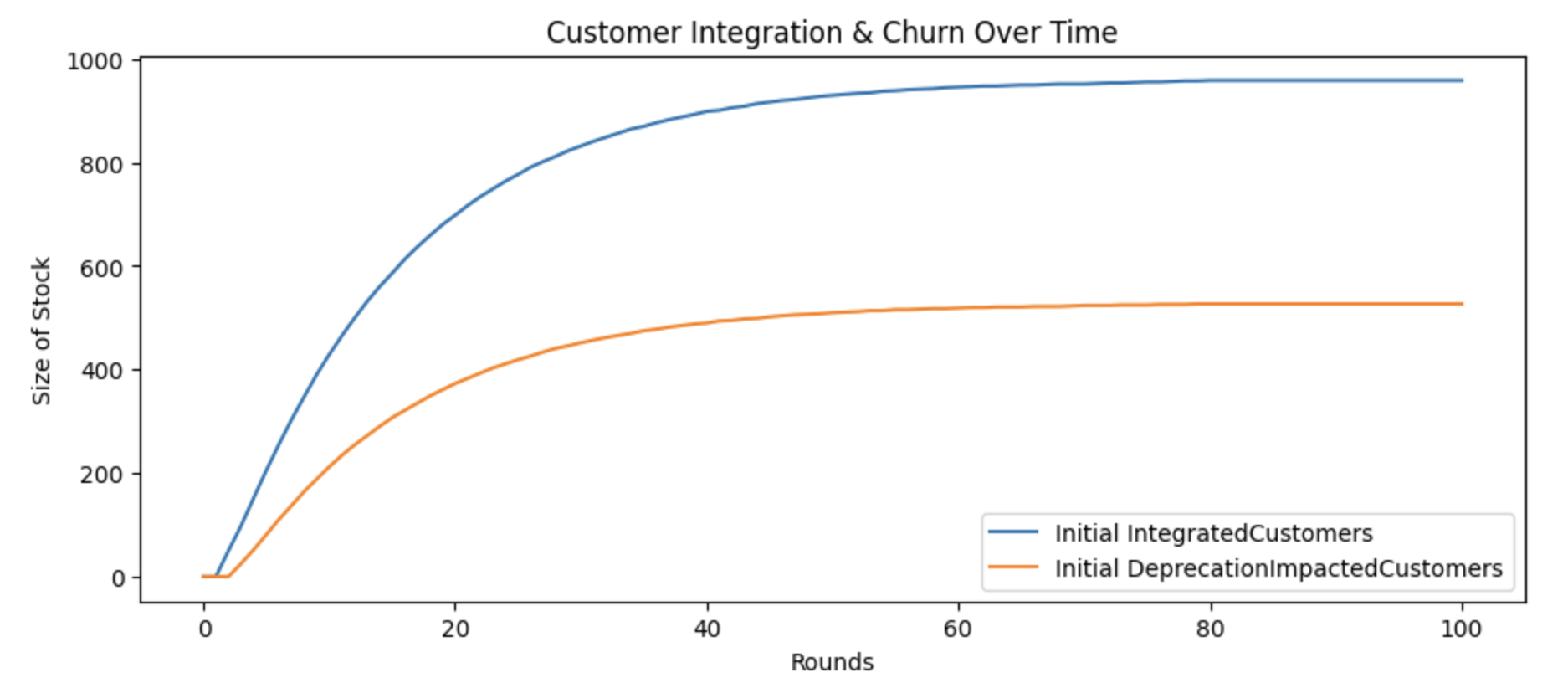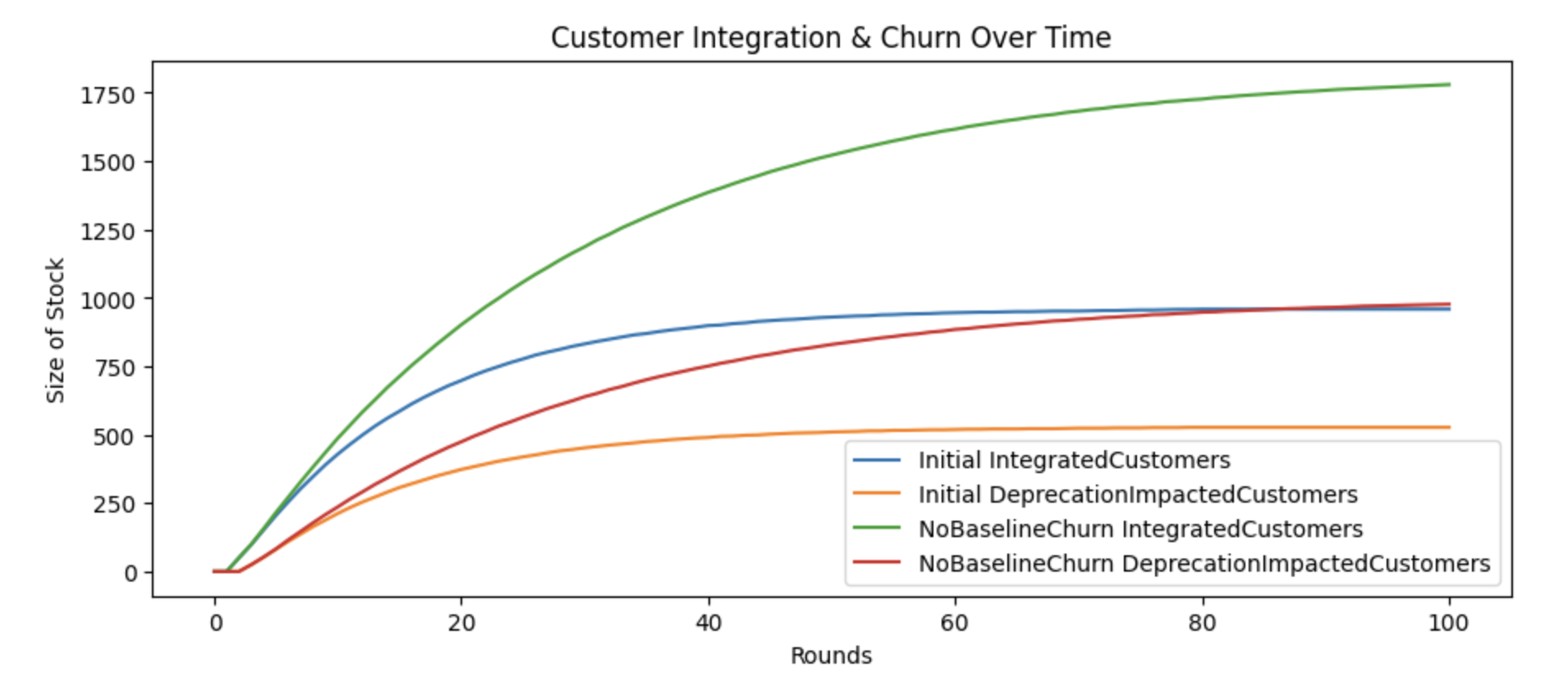Systems model of API deprecation
In How should Stripe deprecate APIs?, the diagnosis depends on the claim that deprecating APIs is a significant cause of customer churn. While there is internal data that can be used to correlate deprecation with churn, it’s also valuable to build a model to help us decide if we believe that correlation and causation are aligned in this case.
In this chapter, we’ll cover:
- What we learn from modeling API deprecation’s impact on user retention
- Developing a system model using the lethain/systems package on GitHub. That model is available in the lethain/eng-strategy-models repository
- Exercising that model to learn from it
Time to investigate whether it’s reasonable to believe that API deprecation is a major influence on user retention and churn.
Learnings
In an initial model that has 10% baseline for customer churn per round, reducing customers experiencing API deprecation from 50% to 10% per round only increases the steady state of integrated customers by about 5%.

Impact of 10% and 50% API deprecation on integrated customers
However, if we eliminate the baseline for customer churn entirely, then we see a massive difference between a 10% and 50% rate of API deprecation.

Impact of rates of API deprecation with zero baseline churn
The biggest takeaway from this model is that eliminating API-deprecation churn alone won’t significantly increase the number of integrated customers. However, we also can’t fully benefit from reducing baseline churn without simultaneously reducing API deprecations. Meaningfully increasing the number of integrated customers requires lowering both sorts of churn in tandem.
Sketch
We’ll start by sketching the model’s happiest path: potential customers flowing into engaged customers and then becoming integrated customers. This represents a customer who decides to integrate with Stripe’s APIs, and successfully completes that integration process.

Happiest path for Stripe API integration
Business would be good if that were the entire problem space. Unfortunately, customers do occasionally churn. This churn is represented in two ways:
baseline churnwhere integrated customers leave Stripe for any number of reasons, including things like dissolution of their companyexperience deprecationfollowed bydeprecation-influenced churn, which represent the scenario where a customer decides to leave after an API they use is deprecated
There is also a flow for reintegration, where a customer impacted by API deprecation
can choose to update their integration to comply with the API changes.
Pulling things together, the final sketch shows five stocks and six flows.

Final version of systems model for API deprecation
You could imagine modeling additional dynamics, such as recovery of churned customers, but it seems unlikely that would significantly influence our understanding of how API deprecation impacts churn.
Reason
In terms of acquiring customers, the most important flows are customer acquisition and initial integration with the API. Optimizing those flows will increase the number of existing integrations.
The flows driving churn are baseline churn, and the combination of API deprecation and deprecation-influenced churn. It’s difficult to move baseline churn for a payments API, as many churning customers leave due to company dissolution. From a revenue-weighted perspective, baseline churn is largely driven by non-technical factors, primarily pricing. In either case, it’s challenging to impact this flow without significantly lowering margin.
Engineering decisions, on the other hand, have a significant impact on both the number of API deprecations, and on the ease of reintegration after a migration. Because the same work to support reintegration also supports the initial integration experience, that’s a promising opportunity for investment.
Model
You can find the full implementation of this model on GitHub if you want to see the full model rather than these emphasized snippets.
Now that we have identified the most interesting avenues for experimentation, it’s time to develop the model to evaluate which flows are most impactful.
Our initial model specification is:
# User Acquisition Flow
[PotentialCustomers] > EngagedCustomers @ 100
# Initial Integration Flow
EngagedCustomers > IntegratedCustomers @ Leak(0.5)
# Baseline Churn Flow
IntegratedCustomers > ChurnedCustomers @ Leak(0.1)
# Experience Deprecation Flow
IntegratedCustomers > DeprecationImpactedCustomers @ Leak(0.5)
# Reintegrated Flow
DeprecationImpactedCustomers > IntegratedCustomers @ Leak(0.9)
# Deprecation-Influenced Churn
DeprecationImpactedCustomers > ChurnedCustomers @ Leak(0.1)
Whether these are reasonable values depends largely on how we think about the length of each round. If a round was a month, then assuming half of integrated customers would experience an API deprecation would be quite extreme. If we assumed it was a year, then it would still be high, but there are certainly some API providers that routinely deprecate at that rate. (From my personal experience, I can say with confidence that Facebook’s Ads API deprecated at least one important field on a quarterly basis in the 2012-2014 period.)
Admittedly, for a payments API this would be a high rate, and is intended primarily as a contrast with more reasonable values in the exercise section below.
Exercise
Our goal with exercising this model is to understand how much API deprecation impacts customer churn. We’ll start by charting the initial baseline, then move to compare it with a variety of scenarios until we build an intuition for how the lines move.

Initial model stabilizing integrated customers around 1,000 customers
The initial chart stabilizes in about forty rounds, maintaining about 1,000 integrated customers and 400 customers dealing with deprecated APIs. Now let’s change the experience deprecation flow to impact significantly fewer customers:
# Initial setting with 50% experiencing deprecation per round
IntegratedCustomers > DeprecationImpactedCustomers @ Leak(0.5)
# Less deprecation, only 10% experiencing per round
IntegratedCustomers > DeprecationImpactedCustomers @ Leak(0.1)
After those changes, we can compare the two scenarios.

Impact of 10% and 50% API deprecation on integrated customers
Lowering the deprecation rate significantly reduces the number of companies dealing with deprecations at any given time, but it has a relatively small impact on increasing the steady state for integrated customers. This must mean that another flow is significantly impacting the size of the integrated customers stock.
Since there’s only one other flow impacting that stock, baseline churn, that’s the one to exercise next. Let’s set the baseline churn flow to zero to compare that with the initial model:
# Initial Baseline Churn Flow
IntegratedCustomers > ChurnedCustomers @ Leak(0.1)
# Zeroed out Baseline Churn Flow
IntegratedCustomers > ChurnedCustomers @ Leak(0.0)
These results make a compelling case that baseline churn is dominating the impact of deprecation. With no baseline churn, the number of integrated customers stabilizes at around 1,750, as opposed to around 1,000 for the initial model.

Impact of eliminating baseline churn from model
Next, let’s compare two scenarios without baseline churn, where one has high API deprecation (50%) and the other has low API deprecation (10%).

Impact of rates of API deprecation with zero baseline churn
In the case of two scenarios without baseline churn, we can see having an API deprecation rate of 10% leads to about 6,000 integrated customers, as opposed to 1,750 for a 50% rate of API deprecation. More importantly, in the 10% scenario, the integrated customers line shows no sign of flattening, and continues to grow over time rather than stabilizing.
The takeaway here is that significantly reducing either baseline churn or API deprecation magnifies the benefits of reducing the other. These results also reinforce the value of treating churn reduction as a system-level optimization, not merely a collection of discrete improvements.
Next chapter: Why did Stripe build Sorbet? (~2017)
Previous chapter: How should Stripe deprecate APIs? (~2016)
First published at lethain.com/api-deprecation-model/